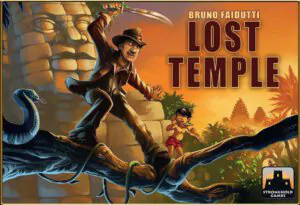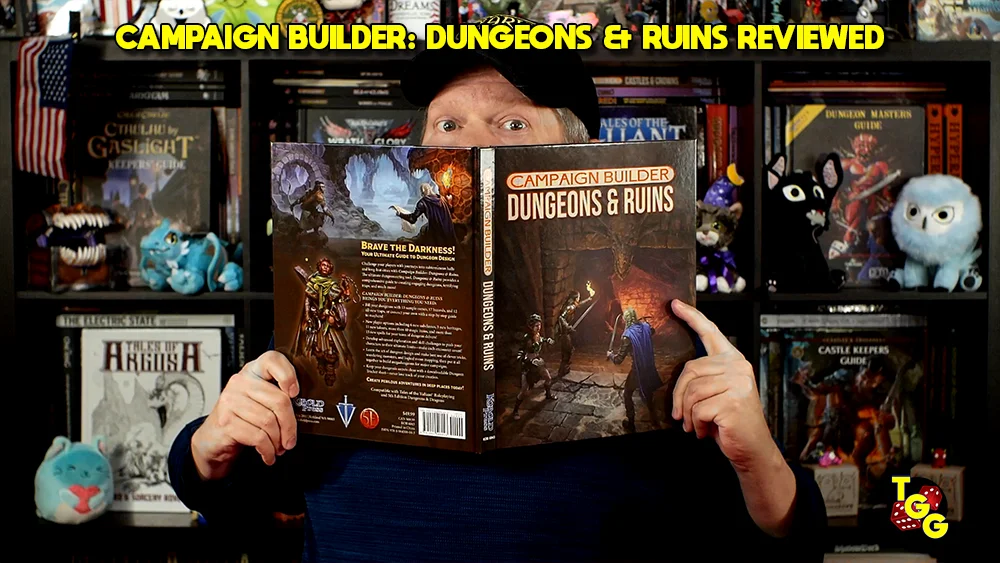Publisher: Stronghold Games
Designer: Bruno Faidutti
Artist: Pierô
Year: 2012
Genre: Card drafting jungle racing game
Players: Two to eight players
Ages: 10+ (Just my estimation)
Playing Time: 45 minutes
MSRP: $34.95
I’m not the sort of gamer who believes that everything which comes my way has to be revolutionary and utterly different than anything else in my collection. Tried and true design or game styles can be welcome as long as they produce the desired effect as we ask the question: Are we having fun? Hopefully the answer is yes and with that being the case I can give a title a passing grade or at least point out what sort of gamers will enjoy giving it a go. Bruno Faidutti’s Lost Temple is a game which squarely falls into this classification for me; it surely wouldn’t be the first game off the shelf if I had a good size group of people over all wanting to play together nor would it be the last to make an appearance either. Nothing earthshaking is introduced in the design – in fact it has a “been there, done that” feel to the proceedings but it can be a good time in the right frame of mind and with the right group of gamers.
As far as the components, Lost Temple is pretty basic fare – it is just a racing game at heart – although I’ll point out the artwork on the cards and board is extremely nice. The tokens, gems, and pawns for each player don’t really stand out but are certainly functional and you can’t ask for much more than that.
All in all Lost Temple is straight forward. Each player is an archeologist looking to find the lost temple (thus the name…) and in order to cross the jungle and find it they’ll need the assistance of the natives. Whoever reaches the temple first is the winner. Set up and explanation of the rules takes all of about five minutes so Lost Temple easily falls into the type of game with which I imagine ramping up or winding down an evening of gaming.
The game has a simple premise: A few archeologists are hunting after a lost temple (hence the name). To cross the jungle and find it, they need the help of the natives. Whoever uses their help best and gets there first, wins. To begin each player randomly gets assigned a starting space and gems – possibly even the machete – and the further back you begin the more you have to work with. It seems as if this is correctly balanced and no one seemed to have any complaints.
Each round begins with drafting one of the native cards, beginning with the player in last place, and the remaining cards are handed to the player to their left. Depending on the number of players some of the native cards may not be in play each round (they’re randomly discarded each shuffle) but with a full complement of eight then all but one are available. The natives are broken into the Shaman, Thief, Seer, Priest, Elder, Craftsman, Scout, Canoe and Child. Each brings with them a special ability such as moving to the next village, paying so many gems to move so many spaces, switching places with another player, and so forth. Not having played Faidutti’s previous design, Citadels, I was told the game plays very similarly by one of my gaming gang. As a matter of fact, this player told me he hated Citadels… Ouch!
Once everyone has a native in hand, the starting player calls out each native in order and whoever has that card takes a gem and then may utilize the card’s special ability. This continues until one person has crossed the finish line and made it to the lost temple.
Thankfully, there’s a little more to the game than simply drafting cards and moving pawns as terrain such as dense jungle can stop a player unless they have a machete, villages, shines, and chance token spots – which could be good or ill – to add a few more wrinkles to play.
Much of the decision making boils down to wondering what someone else may have selected, if you aren’t the starting player, and because some cards may not have been available to begin with you won’t be sure what may happen. Surprisingly, selecting a native leads to some people taking an inordinate amount of time to make their pick so in order to prevent the game from bogging down a set time limit should be decided upon by everyone before you begin.
There’s plenty of ways to screw your neighbor in Lost Temple and I certainly wouldn’t recommend playing with folks who get bent out of shape easily as players change positions in the blink of an eye and any front runner can quickly find themselves sitting in last place. Although there isn’t much meat to the game most races can be real back and forth affairs so the players stay involved throughout the 45 minutes or so it takes to play.
I certainly can’t imagine playing Lost Temple with anything fewer than five players as there isn’t enough under the hood. Although the box states you can play with two, I believe a head to head matchup would be exceptionally boring… Six to eight players really seems to be the sweet spot here.
All in all Lost Temple is what it is, a light family style racing game that possibly serves itself even better as a small party game. It won’t appeal to gamers who dig a high level strategy and the level of take that could be an issue for the thin skinned but overall many casual gamers will find this right up their alley. I think the $35 price tag might be a little steep for Lost Temple but the pricing isn’t completely out of the realm of reality.
[rwp-review id=”0″]
- Tiny Cyberpunk has Landed in PDF - Apr 25, 2025
- Gary’s Appendix: Hardcover Omnibus is Up for Crowdfunding - Apr 25, 2025
- Save on the Coyote & Crow RPG through Bundle of Holding - Apr 25, 2025




















